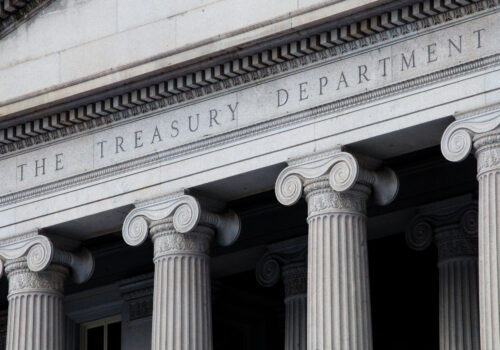On April 22, gold prices reached $3,500 a troy ounce, a record that is roughly double what it was three years ago. Gold has been appreciating in value at a record pace as many other financial assets struggle. This was the case during the 2008 global financial crisis and the COVID-19 pandemic, as well. What is different this time, however, is that the price increase has been driven not just by investors but also by central banks. Since Russia’s full-scale invasion of Ukraine and the Group of Seven’s (G7’s) subsequent imposition of unprecedented sanctions on Russia, central banks that are worried about getting sanctioned, want to protect themselves from a potential global financial crisis, or both have been stacking up gold at record levels.
Governments and private actors alike are giving gold’s role in the global financial system a boost, but with a twenty-first-century twist. Individual countries and groups of countries are experimenting with creating gold-backed digital assets and trading systems that bypass the dollar-denominated financial system. In many cases, these initiatives are for purely economic benefits. However, gold is also being used by US adversaries to evade sanctions or finance activities that counter US national security interests.
The rise of gold-backed currencies that circumvent the US banking system, coupled with sanctioned regimes’ growing interest in the adoption of alternative currencies and payment systems, could create a massive blind spot for US financial intelligence and sanctions enforcement efforts. To reduce the proliferation of these alternatives to the dollar-based financial system, the United States should temper its use of coercive economic measures that can cause gold prices to rise and promote dollarization through trade and investment ties, especially with third countries impacted by sanctions on US adversaries.
Why Russia is interested in gold
Russia’s central bank is among the top holders of gold in the world, having built gold reserves from 2014 to 2020 to hedge against Western sanctions. While the central bank’s gold reserves have not increased substantially since 2020, Russia’s Ministry of Finance is thought to be buying gold from domestic producers without reporting it. In 2021, the Ministry of Finance doubled the share of gold in Russia’s National Wealth Fund to 40 percent.
After the West froze $300 billion of the Russian central bank’s assets in response to Moscow’s full-scale invasion of Ukraine in 2022, this gold-hoarding strategy paid off. As gold prices skyrocketed this year, the value of Russia’s gold reserves increased by $96 billion, offsetting one-third of the frozen assets.
Gold has also played a major role in Russia’s illicit trade. For example, the United Arab Emirates (UAE), a BRICS+ member and a global hub for gold trade, as well as Turkey, have engaged in cash-for-gold trade with Russian banks. The Russia-based Lanta Bank and Vitabank received twenty-one shipments of currencies such as US dollars, euros, UAE dirhams, and Chinese renminbi worth $82 million from the UAE and Turkey in exchange for Russian gold. Late last year, the United States and United Kingdom sanctioned the network of entities and individuals involved in Russia’s illicit gold trade due to their role in generating revenue for Russia’s war chest. Additionally, Britain’s National Crime Agency published a red alert in late 2023 on gold-based illicit trade and sanctions circumvention.
Apart from using gold for reserves and sanctions evasion, Russia is also trying to leverage the BRICS+ grouping as a platform to advocate for the creation of a gold-backed BRICS+ currency. It remains to be seen if the group makes any tangible progress ahead of the next BRICS+ Summit in Brazil in early July. In the meantime, tracking the rise of gold-backed currencies and alternative payment systems across the world offers valuable insights into how they could be used for sanctions evasion.
The rise of gold-backed stablecoins
Gold-backed stablecoins—cryptocurrencies whose prices are pegged to gold—offer the most valuable property of gold, which is stability during financial uncertainty. They are also logistically more convenient to store and sell than physical gold. Companies such as Paxos* and Tether capitalized on these qualities, creating gold-backed stablecoins in 2019 and 2020, respectively.
Usually, each token of gold-backed stablecoin corresponds to a specific amount of gold. For example, by purchasing one unit of Tether Gold (XAUT), investors receive the ownership rights of one troy ounce of physical gold on a specific gold bar with a serial number. Each gold bar weighs four hundred ounces on average, so if investors would like to redeem a gold bar, they have to own units worth one full gold bar. Issuers of these stablecoins hold gold reserves in safe vaults, typically in the United Kingdom or Switzerland. Third parties regularly audit gold reserves to confirm that the supply of tokens does not exceed the amount of gold held by issuers.
Although commodity-backed stablecoins represent less than one percent of the market capitalization of fiat-backed stablecoins, governments are now following the lead of crypto companies in experimenting with them. Earlier this month, for example, the Kyrgyz Ministry of Finance announced that it will launch a gold-backed stablecoin called USDKG in the third quarter of 2025. The Kyrgyz Ministry of Finance holds gold reserves worth $500 million and plans to expand that number up to $2 billion. (This is separate from the gold reserves held by the National Bank of the Kyrgyz Republic, which was among the top buyers of gold in the last quarter of 2024.) USDKG will not track the price of gold, unlike well-established stablecoins such as Paxos Gold or Tether Gold. Instead, it will be pegged to the dollar but solely backed by gold reserves. USDKG holders will be able to redeem gold, other crypto assets, or fiat currency.
The reported objective of the gold-backed stablecoin is to facilitate cross-border inflows of remittances, which make up one-third of Kyrgyzstan’s gross domestic product. Russia accounts for more than 90 percent of remittances that flow into Kyrgyzstan, sent by migrant workers back to their families. Kyrgyzstan has not yet launched the stablecoin, but if it’s going to be used to facilitate cross-border flows with Russia, then there is a chance that certain actors could use USDKG to export sanctioned goods to Russia outside of US authorities’ oversight. Financial institutions in Kyrgyzstan have already been sanctioned for their involvement in Russia sanctions evasion schemes by the United States.
For example, earlier this year, the Treasury Department sanctioned Kyrgyzstan-based Keremet Bank for facilitating transactions on behalf of US-sanctioned Russian bank Promsvyazbank. The Kyrgyz Ministry of Finance sold the controlling shares of Keremet Bank to a firm connected to a Kremlin-linked Russian oligarch in 2024. According to the Treasury press release, the transaction was intended to turn Keremet Bank into a sanctions evasion hub that would enable Russia to receive payments for exports and pay for imports. Given sanctioned Russians’ strong interest in taking advantage of Kyrgyzstan’s financial system to import restricted technologies, they will likely be drawn to USDKG because of its ability to process transactions with Kyrgyz entities while completely bypassing the US banking system.
How the US can stem the digital gold rush
It is no coincidence that stablecoins account for 63 percent of all illicit crypto transactions and have become a preferred tool for sanctions evasion. They attract sanctioned entities because of their ability to transfer value pseudonymously with high speed and at low cost. While the US Senate recently advanced the GENIUS Act to regulate stablecoins, one of the major deficiencies of the bill is that it does not adequately regulate offshore stablecoin issuers. Even if put into law, the GENIUS Act would fail, for example, to regulate Tether, the largest offshore issuer of dollar-pegged stablecoins, which has been the subject of federal investigations because of its alleged widespread use by terrorist groups and Russian arms dealers.
Unlike US-issued or dollar-backed stablecoins, foreign-issued gold-backed stablecoins such as USDKG will likely escape US regulation because they don’t have a touchpoint with the US banking system. Their proliferation, along with gold-backed trading schemes, is driven to a large extent by the United States’ weaponization of the dollar, as well as uncertainty over US trade policy.
The United States has the power to indirectly reduce gold prices and encourage the adoption of dollar-backed assets by returning to being the provider of stability in the global economy. That can be achieved by dialing down the use of tariffs and other economic measures that could cause governments and private actors to turn to gold.
At the same time, the US government should promote the dollarization of economies such as Kyrgyzstan’s by continuing to provide financial assistance and deepening trade and investment ties with other third countries impacted by sanctions against Russia. Doing so will help close gaps in US financial intelligence, strengthen US sanctions enforcement, and lower the demand for currencies outside the dollar-based financial system.
Kimberly Donovan is the director of the Economic Statecraft Initiative within the Atlantic Council’s GeoEconomics Center. She is a former senior Treasury official and National Security Council director. Follow her at @KDonovan_AC.
Maia Nikoladze is an associate director at the Atlantic Council’s Economic Statecraft Initiative within the GeoEconomics Center.
Note: Paxos is a partner of the Atlantic Council’s GeoEconomics Center.
Further reading
Mon, Apr 28, 2025
Modernizing the tools of economic statecraft to meet the challenges of today
Issue Brief By
As the current administration revisits the functions and mechanics of government, near-term steps can be taken, under existing statutory authorities, to modernize how the United States uses its economic strength to combat national security threats and promote American interests.
Wed, Apr 30, 2025
US-EU sanctions divergence would spell trouble for multinational companies
Econographics By Jesse Sucher
The fracturing of traditional alliances carries significant consequences for companies facing multijurisdictional compliance obligations, meaning an already complex situation will become more chaotic.
Wed, Mar 26, 2025
There’s a right way to lift sanctions on Russia. Follow these Dos and Don’ts.
New Atlanticist By Daniel Fried, Kimberly Donovan
A former US diplomat and a former US Treasury official offer eleven guiding principles for moving forward in negotiations on sanctions relief with Russia.
Image: 24 karat gold bars are seen at the United States West Point Mint facility in West Point, New York June 5, 2013. Demand for U.S. gold coins is still at "unprecedented" high levels almost two months after an historic sell-off in gold released years of pent-up demand from retail investors, the head the U.S. Mint said on Wednesday. REUTERS/Shannon Stapleton




